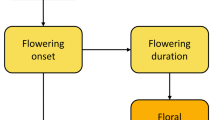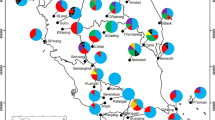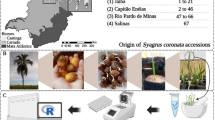Abstract
Highly frequent pollination at short distances combined with spatial genetic structure (SGS) among reproductive individuals, as observed in populations of many forest tree species, may lead to highly frequent pollinations between genetically related individuals located close to each other. This could increase frequencies of biparental inbreeding and strengthen the degree of SGS across generations. However, the degree of SGS observed in forest tree populations is not usually strong, suggesting that such processes are restricted by other factors, which may include inbreeding depression. To test this hypothesis, we examined inbreeding depression in Castanopsis sieboldii saplings in a population known to have significant SGS and high frequencies of short-distance pollination. We determined genotypes at eight microsatellite loci of 125 adult trees and 899 saplings in a 4-ha plot. The neighborhood model approach, assuming an exponential power function, showed highly frequent pollination at short distance among parents of saplings. SGS was significantly stronger among saplings than among adults. The average value of F is (individual inbreeding coefficient based on kinship coefficients between genes within individuals) was also significantly higher among saplings than among adults. Furthermore, average values for saplings were relatively high (0.036–0.052) in 30–50 to 90–110 cm height classes and rapidly decreased to 0.006 for the ≥110-cm class. Analysis of covariance, taking into account the canopy state, showed that inbreeding depression had a significant negative effect on the saplings’ height. Thus, the level of inbreeding in saplings decreased with size classes increasing, probably due to pronounced inbreeding depression resulting in mortality or reduced growth of inbred saplings, and hence, the inbreeding depression may prevent increasing of the level of inbreeding and the degree of SGS in subsequent generations.



Similar content being viewed by others
References
Austerlitz F, Dick CW, Dutech C, Klein EK, Oddou-Muratorio S, Smouse PE, Sork VL (2004) Using genetic markers to estimate the pollen dispersal curve. Mol Ecol 13:937–954
Bittencourt JVM, Sebbenn AM (2007) Patterns of pollen and seed dispersal in a small, fragmented population of the wind-pollinated tree Araucaria angustifolia in southern Brazil. Heredity 99:580–591
Burczyk J, Adams WT, Birkes DS, Chybicki IJ (2006) Using genetic markers to directly estimate gene flow and reproductive success parameters in plants on the basis of naturally regenerated seedlings. Genetics 173:363–372
Canham CD (1989) Different responses to gaps among shade-tolerant tree species. Ecology 70:548–550
Charlesworth D, Charlesworth B (1987) Inbreeding depression and its evolutionary consequences. Ann Rev Ecol Syst 18:237–268
Chybicki IJ, Burczyk J (2010) NM+: software implementing parentage-based models for estimating gene dispersal and mating patterns in plants. Mol Ecol Resour 10:1071–1075
Clark JS (1998) Why trees migrate so fast: confronting theory with dispersal biology and the paleorecord. Am Nat 152:204–224
Doerksen TK, Bousquet J, Beaulieu J (2014) Inbreeding depression in intra-provenance crosses driven by founder relatedness in white spruce. TGG 10:203–212
Hardy OJ, Vekemans X (2002) SPAGeDi: a versatile computer program to analyse spatial genetic structure at the individual or population levels. Mol Ecol Notes 2:618–620
Hardy OJ, Maggia L, Bandou E, Breyne P, Caron H, Chevallier M, Doligez A, Dutech C, Kremer A, Latouche-Halle C, Troispoux V, Veron V, Degen B (2006) Fine-scale genetic structure and gene dispersal inferences in 10 neotropical tree species. Mol Ecol 15:559–571
Husband BC, Schemske DW (1996) Evolution of the magnitude and timing of inbreeding depression in plants. Evolution 50:54–70
Inanaga M, Nakanishi A, Torimaru T, Nishimura N, Tomaru N (2014) Distance-dependent but genetically random mating in a Japanese beech (Fagus crenata) population. Botany 92:1–9
Isagi Y, Saito D, Kawaguchi H, Tateno R, Watanabe S (2007) Effective pollen dispersal is enhanced by the genetic structure of an Aesculus turbinata population. J Ecol 95:983–990
Itow S (1991) Species turnover and diversity patterns along an evergreen broad-leaved forest coenocline. J Veg Sci 2:477–484
Loiselle BA, Sork VL, Nason J, Graham C (1995) Spatial genetic structure of a tropical understory shrub, Psychotria officinalis (Rubiaceae). Am J Bot 82:1420–1425
Lumaret R, Yacine A, Berrod A, Romane F, Li TX (1991) Mating system and genetic diversity in holm oak (Quercus ilex L Fagaceae). In: Fineschi S, Malvolti ME, Cannata F, Hattemer HH (eds) Biochemical markers in the population genetics of forest trees. SPB Academic Publishers, The Hague, pp 149–153
Manabe T, Nishimura N, Miura M, Yamamoto S (2000) Population structure and spatial patterns for trees in a temperate old-growth evergreen broad-leaved forest in Japan. Plant Ecol 151:181–197
Marshall TC, Slate J, Kruuk LEB, Pemberton JM (1998) Statistical confidence for likelihood-based paternity inference in natural populations. Mol Ecol 7:639–655
Miura M, Yamamoto S (2003a) Effects of sprouting and canopy states on the structure and dynamics of a Castanopsis cuspidata var. sieboldii sapling population in an old-growth evergreen broad-leaved forest. For Ecol Manag 183:387–400
Miura M, Yamamoto S (2003b) Structure and dynamics of a Castanopsis cuspidata var. sieboldii population in an old-growth, evergreen, broad-leaved forest: the importance of sprout regeneration. Ecol Res 18:115–129
Nakanishi A, Tomaru N, Yoshimaru H, Kawahara T, Manabe T, Yamamoto S (2004) Patterns of pollen flow and genetic differentiation among pollen pools in Quercus salicina in a warm temperate old-growth evergreen broad-leaved forest. Silvae Genetica 53:258–264
Nakanishi A, Tomaru N, Yoshimaru H, Manabe T, Yamamoto S (2009) Effects of seed- and pollen-mediated gene dispersal on genetic structure among Quercus salicina saplings. Heredity 102:182–189
Nakanishi A, Yoshimaru H, Tomaru N, Miura M, Manabe T, Yamamoto S (2012) Patterns of pollen flow in a dense population of the insect-pollinated canopy tree species Castanopsis sieboldii. J Hered 103:547–556
Oddou-Muratorio S, Bontemps A, Klein EK, Chybicki I, Vendramin GG, Suyama Y (2010) Comparison of direct and indirect genetic methods for estimating seed and pollen dispersal in Fagus sylvatica and Fagus crenata. For Ecol Manag 259:2151–2159
Raymond M, Rousset F (1995) GENEPOP (version 1.2): population genetics software for exact tests and ecumenicism. J Hered 86:248–249
R Development Core Team (2012) R: a language and environment for statistical computing. R Foundation for Statistical Computing, Vienna
Ritland K (1996) Inferring the genetic basis of inbreeding depression in plants. Genome 39:1–8
Rousset F (2000) Genetic differentiation between individuals. J Evol Biol 13:58–62
Runkle JR (1981) Gap regeneration in some old-growth forests of the eastern United States. Ecology 62:1041–1051
Setsuko S, Ishida K, Ueno S, Tsumura Y, Tomaru N (2007) population differentiation and gene flow within a metapopulation of a threatened tree, Magnolia stellata (Magnoliaceae). Am J Bot 94:128–136
Silvertown JW, Charlesworth D (2001) Introduction to plant population biology, 4th edn. Blackwell Science, Oxford
Ubukata M, Itahana N, Kohono K (1999) Examination of the mating system of Mizunara (Quercus mongolica var. grosseserrata) in a natural stand based on spatial genetic structure and inbreeding depression. J Jpn For Soc 81:280–285
Vekemans X, Hardy OJ (2004) New insights from fine-scale spatial genetic structure analyses in plant populations. Mol Ecol 13:921–935
Wright S (1943) Isolation by distance. Genetics 28:114–138
Wright S (1946) Isolation by distance under diverse systems of mating. Genetics 31:39–59
Acknowledgments
Field and laboratory assistance was provided by members of the Laboratory of Forest Ecology and Physiology of Nagoya University, whose help is gratefully acknowledged. We thank the Tsushima District Forest Office for allowing us to undertake this study, which was supported by Grants-in-Aid for Scientific Research (Nos. 11460069 and 14206017) from the Japan Society for the Promotion of Science.
Data archiving statement
We follow standard Tree Genetics and Genomes policy. All the ecological and genotype data will be deposited in the Dryad-Repository.
Author information
Authors and Affiliations
Corresponding author
Additional information
Communicated by J. Beaulieu
This article is part of the Topical Collection on Population structure
Rights and permissions
About this article
Cite this article
Nakanishi, A., Yoshimaru, H., Tomaru, N. et al. Inbreeding depression at the sapling stage and its genetic consequences in a population of the outcrossing dominant tree species, Castanopsis sieboldii . Tree Genetics & Genomes 11, 62 (2015). https://doi.org/10.1007/s11295-015-0890-x
Received:
Revised:
Accepted:
Published:
DOI: https://doi.org/10.1007/s11295-015-0890-x




